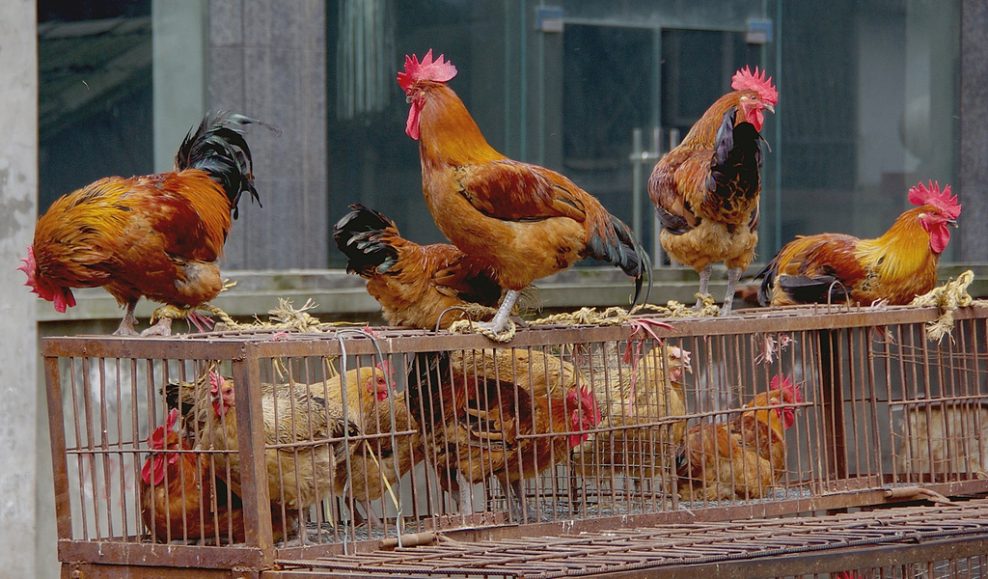Chickens spread latest deadly bird flu
Only a matter of time before H7N9 virus spreads beyond China, researchers warn

Live chickens for sale at a market in China’s Sichuan province. Market chickens, such as these, sparked a new wave of bird flu in 2014, new data show.
Eric/ Flickr (CC BY-NC-ND 2.0)
Chickens spread the second wave of a new and deadly bird flu that hit China last year, data now show.
A third wave of the virus is now spreading. That makes pinpointing the source of this virus important. Doing so could help prevent the disease from spilling over into other countries.
H7N9 is one of the many versions, or strains, of the virus hat causes influenza. It originally spread southward from the Zhejiang province in Eastern China. It has since has evolved, creating at least three local varieties. Researchers shared their new findings in a study published online March 11 in the journal Nature.
Birds carry many influenza viruses. These include the H7N9 types. Although flu viruses often start as bird infections, some adapt in ways that allow them to infect people. That’s why many people pick up H7N9 flu from exposure to infected birds. But this virus can’t yet pass easily from person to person. Scientists worry, though, that the virus could evolve that ability too. If it does, the virus would be one step closer to becoming a pandemic. That’s an outbreak of some infectious disease that affects a large share of people within a country or across the world.
The H7N9 virus first became a concern in spring 2013. That’s when it struck 136 people in China. About 40 of them died. The virus nearly disappeared during the summer, but reemerged in the fall. That second wave, from October 2013 to September 2014, sickened 318 people and killed more than 100. A third wave of infections began in October 2014. So far, more than 640 people have become infected by the virus.
Researchers do not know why the virus bounced back so strongly last year. To learn more, Tommy Tsan-Yuk Lam of the University of Hong Kong and his colleagues went looking for its source. The team took samples from markets that sold live poultry in five Chinese provinces and from a hospital in China.
Although chickens can pick up and host the H7N9 germ, it does not make them sick. Their lack of symptoms makes it hard to tell which, if any of them, carry the virus.
On average, the new study found, 3 percent of market chickens hosted the virus. That suggests live birds are spreading the disease. Poultry traders probably helped the virus spread to other parts of China as they moved infected birds from place to place.
Lam’s team recommends permanently closing China’s live poultry markets. If not, it will only be a matter of time before this virus spreads further, the researchers write.
The fact that H7N9 has picked up genes from other bird-flu viruses worries scientists. Those genes may enable this bird-flu virus to more easily infect people. And that makes H7N9 a major candidate to emerge as pandemic strain, the researchers say.
Power Words
(for more about Power Words, click here)
avian Of or relating to birds.
epidemic A widespread outbreak of an infectious disease that sickens many people (or other organisms) in a community at the same time.
gene (adj. genetic) A segment of DNA that codes, or holds instructions, for producing a protein. Offspring inherit genes from their parents. Genes influence how an organism looks and behaves.
germ Any one-celled microorganism, such as a bacterium, fungal species or virus particle. Some germs cause disease. Others can promote the health of higher-order organisms, including birds and mammals. The health effects of most germs, however, remain unknown.
infection A disease that can spread from one organism to another.
infectious An adjective that describes a type of germ that can be transmitted to people, animals or other living things.
influenza (or flu) A highly contagious viral infection of the respiratory passages causing fever and severe aching. It often occurs as an epidemic.
pandemic An epidemic that affects a large proportion of the population across a country or the world.
poultry Chickens, ducks, geese, pheasants and turkeys that are raised by people. In the wild, these same birds are referred to as fowl.
strain (in biology) Organisms that belong to the same species that share some small but definable characteristics. For example, biologists breed certain strains of mice that may have a particular susceptibility to disease. Certain bacteria or viruses may develop one or more mutations that turn them into a strain that is immune to the ordinarily lethal effect of one or more drugs.
virus Tiny infectious particles consisting of RNA or DNA surrounded by protein. Viruses can reproduce only by injecting their genetic material into the cells of living creatures. Although scientists frequently refer to viruses as live or dead, in fact no virus is truly alive. It doesn’t eat like animals do, or make its own food the way plants do. It must hijack the cellular machinery of a living cell in order to survive.







